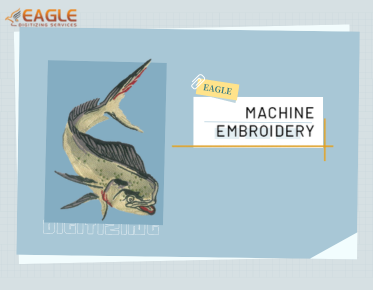Quick Tips on How to Improve Embroidery Digitizing Quality
Embroidery digitizing is an art form, that transforms intricate designs into captivating embroidered pieces. It is a meticulous process that requires both technical skills and an eye for detail. By understanding the secrets behind high-quality embroidery digitizing, you can elevate your projects to new heights. The journey begins with recognizing why quality matters in this craft and how it can make or break your creations.
Why Quality Matters: The Impact on Your Projects
Quality is not just a buzzword; it is the cornerstone of successful embroidery projects. A well-digitized design not only enhances the aesthetic appeal but also ensures durability and longevity. Poor quality can lead to frayed edges, uneven stitching, and a finished product that fails to impress. Whether you're crafting custom apparel or intricate art pieces, the quality of your digitized designs directly influences the outcome. High-quality embroidery digitizing is your gateway to stunning, professional-grade pieces that leave a lasting impression.
Essential Tools for Quality Digitizing
Software Choices: What to Look for in Digitizing Software
Choosing the right software for embroidery digitizing is akin to selecting the perfect brush for a painter. Look for programs that offer advanced features such as automatic stitch generation, intuitive user interfaces, and robust editing capabilities. Programs like Wilcom, Hatch, and Brother’s PE-Design are excellent choices that empower users to unleash their creativity. Familiarity with the software can also make a significant difference. Invest time in learning its nuances, as this knowledge will enhance the quality of your digitizing efforts.
The Importance of a Good Computer: Hardware Considerations
A reliable computer is the backbone of successful embroidery digitizing. Opt for a machine with a powerful processor, ample RAM, and a dedicated graphics card to handle complex designs efficiently. When digitizing, you’ll often be working with high-resolution files, so ensuring your hardware can manage these demands is crucial. A slow computer can lead to lag and frustration, hampering your creative flow.
Scanners and Input Devices: Best Practices for Capturing Designs
For those who prefer starting with physical artwork, a high-quality scanner is essential. Look for scanners that offer high resolution and color accuracy to capture intricate details. Flatbed scanners are particularly effective for larger designs, while handheld models can be useful for smaller pieces. Additionally, using a graphics tablet can streamline the process, allowing for greater precision when tracing or modifying designs digitally.
Analyzing Design Quality Before Digitizing
The Role of Original Artwork: Quality Starts Here
The foundation of great embroidery digitizing lies in the quality of the original artwork. Whether it's a sketch, painting, or digital illustration, the design must be clear, well-defined, and suitable for embroidery. Consider the complexity of the design; overly intricate details may not translate well into stitches.
Tips for Selecting the Right Images for Digitizing
When selecting images for digitizing, opt for high-resolution files with clear outlines. Vector images often work best, as they can be resized without losing quality. Avoid images with excessive gradients or shadows, as these can complicate the digitizing process. Simplicity is key; a well-defined design will yield better results.
Adjusting Designs for Embroidery: Simplification Techniques
Before digitizing, simplifying the design can significantly improve the embroidery outcome. This might involve removing unnecessary elements, reducing the number of colors, or creating bolder outlines. By streamlining the design, you enhance its visual impact and make the digitizing process smoother.
Mastering Stitch Types and Techniques
Different Stitch Types Explained: Satin, Fill, and More
Understanding various stitch types is vital for effective embroidery digitizing. Satin stitches are perfect for borders and lettering, offering a sleek, polished finish. Fill stitches provide coverage for larger areas while running stitches are ideal for fine details. Mastering these techniques enables you to choose the most appropriate stitch type for each section of your design.
Choosing the Right Stitch Type for Your Design
When deciding on stitch types, consider the design's elements and intended look. For example, intricate designs may benefit from a combination of satin and fill stitches, providing contrast and depth. Additionally, factor in the fabric type, as some stitches work better on specific materials. Experimentation is key; don’t hesitate to test different combinations to find what best suits your design.
How Stitch Density Affects Quality: Finding the Sweet Spot
Stitch density refers to the number of stitches per inch in a design. Finding the right balance is crucial; too few stitches can result in a flimsy design, while too many can lead to stiffness and thread breakage. Generally, a density of 8-10 stitches per millimeter works well for most fabrics, but adjustments may be needed based on the design and material. Testing different densities is essential to achieve optimal quality.
Managing Color Effectively
The Importance of Color Selection in Digitizing
Color selection is a powerful aspect of embroidery digitizing. The colors you choose will impact not only the aesthetic appeal but also the overall effectiveness of the design. Bold, vibrant colors can attract attention, while subtle hues may create a more elegant look. Consider the fabric color as well, ensuring there is sufficient contrast for your design to stand out.
How to Use Color Gradients and Blends for a Professional Look
Incorporating color gradients and blends can elevate your embroidery design, providing depth and dimension. While not all embroidery machines can handle complex color transitions, experimenting with thread shades can create a visually stunning effect. Using a combination of similar shades within a limited palette can achieve a gradient look while maintaining clarity.
Color Separation Techniques: Ensuring Accurate Embroidery
Color separation is critical for achieving accurate embroidery. When digitizing, ensure each color is designated to its own layer within the software. This makes it easier for the embroidery machine to read the design and reduces the risk of color bleed. Familiarize yourself with color separation techniques specific to your digitizing software to enhance accuracy.
Optimizing Design Placement and Sizing
Best Practices for Placement: Where to Position Your Design
Placement is key to creating visually appealing embroidery. Consider the garment or item you’re working on and the intended focus of the design. Centering the design, aligning it with seams, or placing it at an angle can create dynamic effects. Testing placement on similar fabric swatches can provide valuable insights before finalizing your design.
How Sizing Affects Stitching: Avoiding Common Pitfalls
Sizing plays a pivotal role in the success of your embroidery project. If a design is too small, details may get lost or become unrecognizable. Conversely, overly large designs may distort when stitched. A general rule is to keep detailed designs no smaller than 1 inch, allowing enough room for clarity and precision.
The Impact of Hooping: Ensuring Your Fabric Stays in Place
Proper hooping is essential for maintaining fabric stability during the embroidery process. Make sure the fabric in the hoop is taut without being overstretched. This prevents shifting, puckering, and misalignment, which can ruin your design. Use stabilizers as needed to support the fabric and enhance stitch quality.
Refining Your Digitizing Skills
Continuous Learning: Online Courses and Resources for Improvement
Embroidery digitizing is a field where learning never truly ends. Numerous online courses and resources are available to help you hone your skills. Websites like Udemy and Craftsy offer courses tailored to different skill levels, covering everything from software basics to advanced techniques.
Practicing with Different Fabrics: Understanding Material Behavior
Each fabric behaves differently during the embroidery process. Practicing with various materials allows you to understand how they respond to different stitch types and densities. Cotton, polyester, and specialty fabrics each present unique challenges and opportunities for creativity.
Joining Embroidery Communities: Collaborating and Sharing Tips
Engaging with embroidery communities can significantly enhance your skills. Online forums, social media groups, and local clubs offer platforms to share experiences, ask questions, and receive feedback. Collaborating with fellow enthusiasts can spark new ideas and techniques that elevate your craft.
Testing and Sampling Your Designs
The Importance of Test Stitching: Why You Should Always Sample
Never underestimate the power of test stitching. Sampling your designs on similar fabric allows you to assess the quality before committing to the final product. This crucial step helps identify potential issues, such as tension problems or color inaccuracies, saving you time and resources in the long run.
Analyzing Test Results: What to Look for in Quality
Once you’ve completed your test stitch, carefully analyze the results. Look for issues like thread breaks, uneven stitching, or puckering. Assess the color accuracy and ensure the design retains its intended appearance. Document any adjustments needed to refine your final design.
Making Adjustments Based on Feedback: Iterating for Improvement
Feedback is a valuable tool in the embroidery digitizing process. Whether it comes from peers, clients, or test samples, use constructive criticism to inform your adjustments. Iterating your designs based on feedback allows you to enhance quality and ultimately produce a more polished final product.
Common Challenges in Embroidery Digitizing
Tackling Issues with Underlay and Stabilizers
Underlay and stabilizers are crucial for preventing fabric distortion and improving stitch quality. If underlays are insufficient, the design may lack stability, leading to undesirable results. Ensure you understand how different stabilizers interact with various fabrics to mitigate these challenges effectively.
How to Handle Fabric Pull and Tension Problems
Fabric pull and tension issues are common hurdles in embroidery digitizing. Ensure that the tension settings on your embroidery machine are calibrated correctly to avoid thread breaks and uneven stitching. Additionally, using the appropriate stabilizer can help reduce fabric pull, ensuring your design remains intact.
Solutions for Thread Breaks and Snags: Preventative Measures
Thread breaks and snags can be frustrating, but many preventative measures exist. Regularly check the condition of your threads and needles, as worn-out components can lead to issues. Adjusting tension settings and using high-quality thread can also minimize the risk of breaks and snags.
Quality Control and Final Checks
Establishing a Quality Control Process: Ensuring Consistency
Implementing a quality control process is essential for maintaining consistency in your embroidery projects. Create a checklist to evaluate each design, from the initial digitizing stage to the final product. Consistent checks can catch potential errors before they escalate, ensuring every piece meets your standards.
The Importance of Reviews: Getting Feedback from Peers
Peer reviews are invaluable in the world of embroidery digitizing. Sharing your work with fellow designers can provide fresh perspectives and constructive criticism. This collaborative approach can lead to improvements you may not have considered, ultimately enhancing your overall quality.
Finalizing Your Design: Last-Minute Checks Before Production
Before sending your design into production, conduct thorough last-minute checks. Ensure all elements are correctly positioned, colors are accurate, and stitch types are suitable. A final review can prevent costly mistakes and ensure that the final product meets your expectations.
Embroidery digitizing is a journey filled with opportunities for creativity and expression. As you explore the intricacies of this craft, embrace the challenges and experiment with new techniques and tools. Each project is an opportunity to refine your skills and elevate your embroidery digitization game.
With practice, patience, and a commitment to quality, you can transform your designs into stunning works of art. Whether you’re a novice or a seasoned professional, the world of embroidery digitizing awaits your exploration. Dive in, unleash your creativity, and watch your embroidery dreams come to life!
.png)


